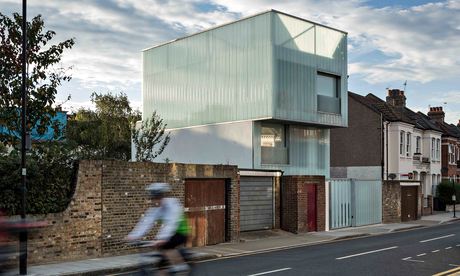
10. Slip House, Brixton, London
Slip House is a flexible, eco-minimalist haven that successfully reimagines the urban terraced home. This translucent, three-storey house rises ethereally from a row of traditional Victorian houses in south London. Perceived as "a vehicle for in-house research into sustainable design" it is the home of architect Carl Turner and his partner Mary Martin.
The multi-award-winning house is constructed of three "slipped" stacked boxes that cantilever towards the street. Each box serves a separate function and each has been carefully placed to maximise light and outlook without encroaching on the neighbours' space or privacy. The shifting planes of the building – which are wrapped in milky planks of glass – also break up the bulk of the property.
At the top of the building, the glass planks extend beyond the roof line to create a secluded roof terrace, screened from the bustle of Brixton below. The planks also surround a set of photovoltaic panels that generate electricity. Beneath the property solar assisted "energy piles" transfer the load of the building to the ground whilst drawing heat from the earth up into the building. Rainwater harvesting, triple glazing, a wildflower roof and a mechanical ventilation system have helped to property achieve a level five (out of a possible six) in the government's code for sustainable homes.
The three open-plan levels (built and furnished for a total of £600,000) are kept deliberately flexible. "We have always described the way we use the house as 'living over the shop', much like the weavers' houses in Spitalfields were conceived as places to work and live," says Turner. "We are interested in new modes of living where the possibility of home working offers more than a desk in the box room."
Turner's studio space is on the ground floor. It has its own entrance from the front courtyard, but is also connected to the main house via an internal door. "The ground floor can be shared or used completely independently," says Turner "or it could be rented out as a separate flat in the future, or as a place for elderly relatives to stay should it be needed".
"The house is a joy to live in," says Turner. "The light quality is amazing and an added benefit of such a well-insulated, triple-glazed building is the lack of noise pollution. The house is very, very quiet. Not only between inside and out, but also the mass of the floors and solid concrete stairs mean there is very little noise transfer within the house."
In-built storage walls and sliding plywood panels have helped the owners achieve a rigorously minimalist aesthetic. "The minimal lines do require a degree of discipline," concedes Turner "but, as Mary says, why would I want to look at the washing up liquid?"
• Read more about Slip House here
Read more:
1. Marsh House in Nottingham
2. 100 Princedale Road in London
3. Underhill House in Gloucestershire
4. Hemp Cottage in County Down
5. The Pavilion in London
6. Plummerswood on the Scottish Borders
7. Lammas in in North Pembrokeshire
8. Zero Carbon House in Balsall Heath, Birmingham
9. Lilac in Bramley, Leeds
10. Slip House in London
We're asking you to vote for your favourite eco home. One voter chosen at random will receive £150 worth of gift vouchers for Nigel's Eco Store. Cast your vote here. Voting closes at 23.59 on Thursday 24 April 2014.
With thanks to: the Green Building Council, Hattie Hartman, sustainability editor at the Architect's Journal, HAB housing, The Green Press, Green Sky Thinking, Superhomes, the Centre for Alternative Technology, BREEAM, and The Built Environment Centre for Northern Ireland.
Interested in finding out more about how you can live better? Take a look at this month's Live Better Challenge here.
The Live Better Challenge is funded by Unilever; its focus is sustainable living. All content is editorially independent except for pieces labelled advertisement feature. Find out more here.

